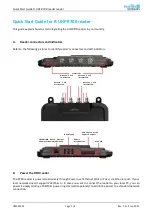
TST-019 MRTALPCH CHANNEL
– Rev. 2016-310
Page 19 of 20
To determine which, first check the
hose. The ends should be square and
straight; if needed, recut each end,
reinstall the hose and repeat the test. If
this does not resolve the leak,
disconnect the reducing fitting and,
using the hose adapters, attach the ball
valve to the ¼" O.D. filter hose. See
FIGURE 27
.
In
FIGURE 27
, the reducer fitting has been
removed and the ball valve (with hose
adapters for 1/4" O.D. hose) has been
attached directly to the filter hose.
If the leak continues, replace the hose, and if this does not resolve the issue, replace the filter.
If the vacuum level of the vacuum gauge holds steady and no longer indicates a leak, this
indicates that the leak was in the reducer fitting, since this is the only part that has changed
since the previous test. Replace the reducer fitting.
15) The final use of the ball valve is to
install it in a line so the lifter’s vacuum
gauge provides a reading for one
section of the circuit being tested and
the ball valve’s vacuum gauge provides
a reading for the remainder of the
circuit. This is shown in
FIGURE 28
,
where the ball valve is being used to
check the connection to the lifter’s
vacuum gauge.
The vacuum gauge is connected with
(white) 1/8" I.D. hose. An adapter fitting
is used to connect the end of the ball
valve without the vacuum gauge to the
hose attached to the lifter’s vacuum
gauge. A second adapter fitting is used,
along with additional 1/8" I.D. hose, to
connect the end of the ball valve with
the vacuum gauge to the Tee fitting
located in the pad line.
With the ball valve in the open position (handle in line with the valve), apply
( )
the lifter.
Allow the lifter to shut off and then close the ball valve (handle turned perpendicular to the
valve) then switch the lifter to off
(
).
Observe the vacuum gauges to locate the cause of the leak. Note, it is possible for both the
following two conditions to exist.
FIGURE 27
FIGURE 28



































